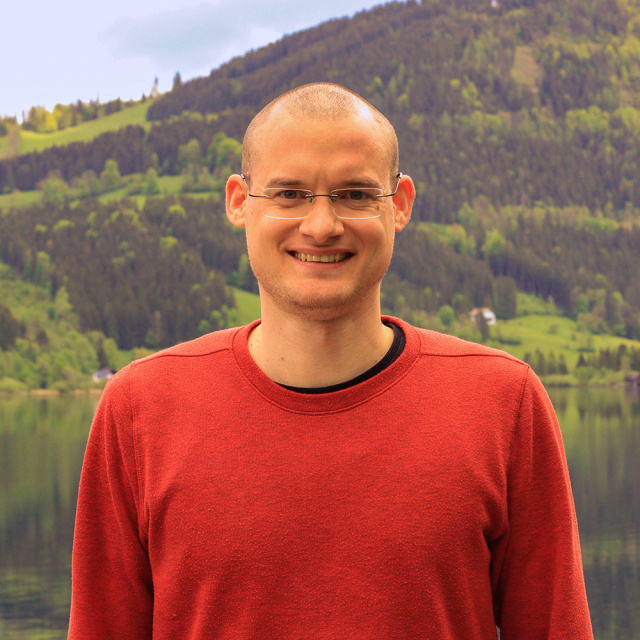Featured Lendület Member: András Abonyi
Riverine plankton communities are of crucial importance in maintaining the ecological health of rivers, yet compared to standing water plankton, the community of riverine floating organisms is very poorly studied. András Abonyi, Senior Research Fellow at the Institute of Aquatic Ecology of the Centre for Ecological Research, is changing this. He is the head of the Momentum Research Group on River Ecology and, with the support of the Momentum Programme, is investigating the transformation of the plankton community in rivers in response to river regulation and changes over time.
Plankton is a community of floating organisms. Planktonic organisms occur in all kinds of natural waters, yet our basic ecological knowledge of them comes almost exclusively from standing water environments (lakes and seas). Plankton in rivers and streams is a highly understudied area; this is a problem because its species composition and organisation differs significantly from that of standing water communities, so its community responses to human impact or global changes cannot be fully estimated based on our previous knowledge.
The importance of distance from the river
This makes the research of András Abonyi, Senior Research Fellow at the Institute of Aquatic Ecology of the Centre for Ecological Research, who will study river plankton with the help of this year’s Momentum grant, unavoidable from both a basic research and nature conservation perspective. The research will cover the biodiversity of the entire plankton community (including bacteria, algae, and zooplankton), but will focus specifically on two trophic levels: the primary producers (phytoplankton) and the primary consumers (zooplankton). The research will cover large rivers, in particular the Danube, and natural and artificial backwaters.
The main question of the examinations is how the biodiversity and organisation of plankton communities differ along the natural spatial gradient of distance from the river.
 András Abonyi Photo: ecolres.hun-ren.hu
András Abonyi Photo: ecolres.hun-ren.hu“The gradient to be investigated is made up of the river itself and the water areas connected to the river in its natural state, that is, the backwaters,” says Abonyi. “When river meanders form naturally, they gradually move away from the main river bed. Ecological succession then starts in the cut-off dead river bed.”
Along the gradient, the stages of ecological succession and their effects on the organisation of plankton communities can be studied. The backwaters closer to the river are naturally connected to the river in a permanent or intermittent way.
With distance, this connection becomes increasingly rare or even disappears.
Here it is important to emphasise the natural character of the backwaters, since many rivers, for example, the Danube and the Tisza, domestically speaking, have been subject to river regulation and have created many artificial backwaters. Artificial separation has a fundamental impact on their physical and chemical characteristics, as well as their biodiversity.
Plankton communities in dead river beds
In the case of the Tisza dead river beds, the researchers will investigate the impact of river regulation on the natural ecological processes of dead river bed formation. Along the Tisza, there are a good number of natural and artificial dead river beds, as well as occasional connections and disconnections of both categories to the river. By assessing these four types of backwaters, we can explore the influence of natural and artificial factors on plankton communities.
“If a backwater is cut off from the river, it becomes trapped in an artificial bed morphology and starts to function as a classic deep lake. This is interesting because, although these backwaters are shallow, their ecological processes are related to those of deeper lakes,” Abonyi says. “The movement of water in them ceases, and temperature stratification may develop in the water column. We expect this temperature stratification to become stronger further away from the river and in the case of artificial generation. We will investigate how this phenomenon affects the biodiversity, organisation and functioning of plankton communities.”
Another question for the Momentum researchers is how plankton communities in rivers will change in the long term: whether species diversity, composition and quantitative relationships between species will change. If so, what are the reasons for this change and what are the implications for the functioning of the aquatic ecosystem, for example, the nutrient utilisation efficiency of trophic levels.
River water is an ecologically selective system due to continuous mixing. This means that the physical conditions challenge the organisms that live there, with few species able to adapt and become dominant within the community. For this reason, it is expected that in riverine plankton, primary production is maximised at lower species richness, that is, the system works “best” at low diversity. The ecologists will investigate how the role of biodiversity and dominance evolves in each system along the river-backwater gradient. Previous results suggest that the role of dominance is expected to be determinant for all communities, but the effects of biodiversity will differ.
The practical side of the research also concerns human water use, whether for recreation or as a reserve drinking water source. Dead river beds, which are thermally stratified and heavily stressed by agriculture, are often characterised by the proliferation of algal species, that is, eutrophication. In many cases, this also calls into question the usability of the water, since some blue-green algae can produce toxins and their mass presence can have a negative impact on the functioning of the entire planktonic community. An additional goal of the Momentum research is to demonstrate that artificially separated dead river beds are more likely to be dominated by undesirable algal species, which have a negative impact on ecosystem-level processes in planktonic communities. In terms of the key to the solution, they want to demonstrate that
continuous water movement and regular contact with the river help in avoiding these adverse conditions.
As part of the research, regular sampling is carried out in the Göd section of the Danube, building on the long-term plankton monitoring programme of the HUN-REN Centre for Ecological Research, which started in 2021. One-off exploratory sampling will be carried out in the plankton communities of the dead river beds along the Tisza. In addition, a new portable experimental system will be set up to study the effects of biodiversity and water movement together. The plankton communities will be studied using both classical microscopy and new generation molecular methods, providing the basis for researchers to explore the impact of biodiversity and community dominance on ecosystem functioning.
River regulation: an achievement or a threat?
The research thus indirectly addresses the negative ecological effects of river regulation,
which run counter to textbook examples of river regulation as a great technical achievement.
According to Abonyi, it is quite obvious to ecology that a regulated river “loses its connection with the water spaces it is naturally connected to: the dead river beds. Our hypothesis is that this has a negative effect on the biological diversity with which the plankton communities of the river and backwaters could respond to new environmental challenges. For example, species that could adapt to an increasingly warming or more variable water cycle environment may disappear.”








